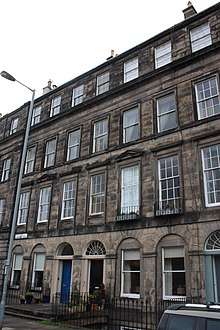Henry Grey (minister)
The Very Rev Dr Henry Grey DD (1778–1859) was a Scottish minister in the Church of Scotland and following the Disruption of 1843 in the Scottish Free Church. He served as Moderator of the General Assembly of the Free Church of Scotland in 1844.
Early life

Grey was born on 11 February 1778, at Alnwick, Northumberland, where his father was a medical practitioner. His education was chiefly left to his mother, who had an early breach with his father, and moved with her son to Edinburgh. There he passed through the usual course of study preparatory to entering into the office of the ministry in the Church of Scotland.[1] He was ordained in 1801.[2]
Ministry
Grey's sympathies were wholly with the evangelical portion of the church, then gradually acquiring position and power. He gained attention and preferment: his first charge was the parish of Stenton in East Lothian. This was a quiet place, where he spent 12 years. In 1813 he was called to St. Cuthbert's Chapel of Ease, a charge recently formed by Sir Henry Wellwood-Moncreiff, 10th Baronet, his colleague-minister in St. Cuthbert's parish. Grey's discourses were presented in a scholarly style and fervent manner, leading the way for Andrew Mitchell Thomson and Thomas Chalmers.[1]
Apocrypha Controversy
In 1821 Grey was appointed to the New North Church, one of the parish churches of Edinburgh, and four years after to St. Mary's, a church recently erected by the town council in a new part of the town. Four years after this last change of post, Grey clashed with Andrew Thomson, and they took opposite sides in the Apocrypha Controversy; they had been warm personal friends.[1]
In the ecclesiastical struggle of the next few years, Grey opposed the civil courts. At the disruption of 1843 he left the Church of Scotland for the Free Church, and had a new church built for him in the parish of St. Mary's. In the year after the disruption, 1844, he was chosen to fill the chair of the church's General Assembly. In the jubilee year of his ministry, a public testimonial was presented to him, which was turned into a foundation for the Grey Scholarships in the New College, Edinburgh.[1]
Grey had taken part in agitation against slavery in the West Indies. A political reformer, he was the target of adverse criticism from some who agreed with his religious views.[1]
Death

Grey retired from active ministry in 1857 with St Mary's being taken over by Rev Thomas Main.[3]
Grey died suddenly in his eighty-first year, on Thursday 13 January 1859[1] at his home 5 East Claremont Street, a very large Georgian flat on the eastern fringe of the Edinburgh New Town.[4]
He is buried in St Cuthbert's Churchyard at the west end of Princes Street[5] with his wife Margaretta (1786-1858) and children Emily Isabella and George Edward Grey. The grave lies in the north-east corner of the northernmost section, abutting the churchyard of St John.
Memorials
A marble bust of Henry Grey stands in New College, Edinburgh, sculpted by Patric Park in 1853.[6]
References
- Stephen, Leslie; Lee, Sidney, eds. (1890). . Dictionary of National Biography. 23. London: Smith, Elder & Co.
- Obituary of Henry Grey February 1859
- Ewing, William Annals of the Free Church
- Edinburgh and Leith Post Office Directory 1858-9
- Monuments and monumental inscriptions in Scotland: The Grampian Society, 1871
- "PMSA NRP: Work Record" (PDF). orapweb.rcahms.gov.uk. 2 June 2011. Retrieved 25 February 2020.
- Attribution
![]()